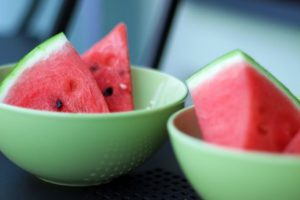by Amy Mullins, PhD, RDN | May 30, 2016
It’s hard to believe that summer is almost here and the kids are out of school! Often times, when kids (and parents too) get away from their normal routine, poor eating and snacking habits creep in. It’s important for kids (and parents) to have a variety of go-to snacks that are tasty, healthy, and easy to prepare!
Put some thought into which snacks make the best choices, and get input from the kids. Children and teenagers are more likely to eat what you buy (and be excited about it!), if they help in the process.
 1.) PLAN: Sit down together and make a list of snack-type foods they might like, and can easily prepare themselves.
1.) PLAN: Sit down together and make a list of snack-type foods they might like, and can easily prepare themselves.
2.) LIST: Make a list of the foods you’ll need to pick up at the grocery store.
3.) SHOP: Take the kids with you shopping… let them help fill the cart with the foods you’ve agreed on.
4.) PREPARE: Allow the kids to help wash, cut, portion, and prepare snacks. This will give them more confidence in the kitchen… now and as a future adult.
Stumped on where to get started? Your best bet is to stay away from processed, pre-packaged snack foods, and sugary drinks. These are typically high in unhealthy fats, oils, and sugar, and lack the vitamins, minerals, and fiber fresh and frozen whole foods have.
Try these super easy and healthy snacks:
- Layer vanilla yogurt and mandarin oranges or blueberries in a tall glass. Top with a sprinkle of granola to make a “parfait”.
- Put cubes of low-fat cheese and grapes on pretzel sticks to make “snack-kabobs”.
- Top a banana with low-fat vanilla and strawberry frozen yogurt and sprinkle with your favorite whole-grain cereal for a healthy “banana-split”.
- Use whole grain (flour or corn) tortillas and top with tomato sauce, cut veggies and shredded cheese. Eat it flat (like a pizza) or roll it up (like a wrap).
Keep your children, and yourself, on track this summer by remembering these main messages from ChooseMyPlate and The Dietary Guidelines:
- Make half your plate fruits and vegetables.
- Focus on whole fruits.
- Vary your veggies.
- Make half your grains whole grains.
- Move to low-fat and fat-free milk or yogurt.
- Vary your protein routine.
- Drink and eat less sodium, saturated fat, and added sugars.
Everything you eat and drink over time matters. The right mix can help you be healthier now and in the future. Start with small changes to make healthier choices you can enjoy. Find your healthy eating style and maintain it for a lifetime.
Find more great ideas with additional resources from MyPlate Snack Tips for Parents
and The Academy of Nutrition and Dietetics 25 Healthy Snacks for Kids.

by Angela Hinkle | May 19, 2016
 “Milk and milk products provide a wealth of nutrition benefits. But raw milk can harbor dangerous microorganisms that can pose serious health risks to you and your family. According to an analysis by the Centers for Disease Control and Prevention (CDC), between 1993 and 2006, more than 1,500 people in the United States became sick from drinking raw milk or eating cheese made from raw milk. In addition, CDC reported that unpasteurized milk is 150 times more likely to cause foodborne illness and results in 13 times more hospitalizations than illnesses involving pasteurized dairy products.”
“Milk and milk products provide a wealth of nutrition benefits. But raw milk can harbor dangerous microorganisms that can pose serious health risks to you and your family. According to an analysis by the Centers for Disease Control and Prevention (CDC), between 1993 and 2006, more than 1,500 people in the United States became sick from drinking raw milk or eating cheese made from raw milk. In addition, CDC reported that unpasteurized milk is 150 times more likely to cause foodborne illness and results in 13 times more hospitalizations than illnesses involving pasteurized dairy products.”
This is an excerpt from the U.S. Food and Drug Administration Protecting and Promoting Your Health website http://www.fda.gov/Food/ResourcesForYou/Consumers/ucm079516.htm. By reading the information and watching the video on this site, you can better understand the dangers of raw milk and how it can affect your family.
Milk is good for you and it tastes great. Just remember to drink it responsibly and safely.
by Angela Hinkle | Apr 1, 2016
“Breaking bread”, or eating a meal with others, is a deeply personal way to foster a sense of belonging. Food is a social glue; it brings us together for conversation, a time to catch up, a chance to connect with loved ones, and it fills our bellies as well.
If you wish to “break bread” (with actual bread), here are some nice, tasty bites of information.
- The hypnotic, heavenly, warm, welcoming aroma of freshly baked bread makes many of us feel that all is right with the world and provides a sense of comfort.
- Researchers have found that the smell of baking bread triggers a positive mood that leads to a higher degree of benevolence, kindness, and concern for the welfare of others.
“Bread – like real love – took time, cultivation, strong loving hands, and patience. It lived, rising and growing to fruition only under the most perfect circumstances”. – Melissa Hill, Something from Tiffany’s
- A fascinating thing about bread is that though it is often viewed as a “poverty fuel”, it can feel like a luxury to even the most monetarily wealthy of individuals.
“”There are people in the world so hungry, that God cannot appear to them except in the form of bread”. – Mahatma Gandhi
- If you’re going to break bread with bread, go for healthy whole grain varieties for plenty of good-for-you minerals, vitamins, and fiber.
Break bread for a healthy life.
by Heidi Copeland | Apr 1, 2016
Can you believe Florida fresh fruits and veggies are supplied to 160 countries around the globe! Particularly abundant right now are the vegetables commonly referred to as cruciferous vegetables. (However, many scientists are starting to favor the term brassica vegetables over cruciferous vegetables) These nutritious veggies are ones that you will want to eat on a regular basis as they are bursting with both macronutrients and micronutrients.
The Florida Department of Agriculture and Consumer Services lists, cabbage, cauliflower, and radishes as being abundant in April for world production. Locally though, growers are turning out broccoli, cabbage, cauliflower, collard greens, kale, kohlrabi, mustard, rutabaga, turnips, bok choy, Chinese cabbage and arugula, as well as radishes.
 There are many simple ways to include cruciferous/brassica vegetables into your diet.
There are many simple ways to include cruciferous/brassica vegetables into your diet.
- Eat them raw! Raw vegetables can make a delicious, crunchy snack especially when served with a low-fat dip.
- Use in recipes! Make slaw, soup or salad, main dishes and even condiments!
- Substitute! Did you know steamed, mashed cauliflower can replace mashed potatoes? Or that coarsely grated cauliflower can replace rice? Folks have even substituted a cauliflower mixture as pizza crust! (okay, it might be a stretch but it does taste good)
Shopping, preparing and storing
- Cruciferous/brassica vegetables are typically inexpensive and can also be found year-round, fresh or frozen.
- Store raw, uncut and unwashed vegetables in the crisper drawer of your refrigerator for up to five days.
Cooking methods:
There are three factors affecting nutrient loss when you cook cruciferous/brassica vegetables:
- Temperature
- Time
- Amount of water used.
The cooking method that best retains nutrients is one that cooks quickly, heats food for the shortest amount of time, and uses as little liquid as possible.
- Using the microwave with a small amount of water essentially steams food from the inside out keeping more vitamins and minerals than almost any other cooking method. http://www.health.harvard.edu/
- Steam vegetables over a small amount of boiling water until a fork can just barely pierce it. (You can save the nutrients that are lost when steaming cauliflower by using the leftover water in a soup)
- Braise, bake or broil, stir-fry or sauté
Cruciferous/brassica vegetables are very unique in that the flower, the root, the stalk and even the leaves can be eaten depending on which plant you are eating.
Try a cruciferous/brassica vegetable a new way or even try a new cruciferous/brassica vegetable a traditional way!
Cauliflower Salad
(Or even use a combination of cauliflower and broccoli and kohlrabi)
Ingredients
2 Tablespoons sliced or diced onion, red, green or white
1 head of cauliflower – including the tender stems, cut into small pieces (or even cut into small florets)
1 Tablespoon sugar
1 Tablespoon vinegar (red wine, white wine, apple cider, or rice wine)
¼ cup mayonnaise
½ cup dried cranberries (or favorite dried fruit)
Salt and pepper to taste
In a large bowl, whisk the sugar, vinegar and mayonnaise together. Season with salt and pepper. Toss in the onion, cauliflower and cranberries and stir until well coated. Eat it right away or savor for a few days.
http://www.freshfromflorida.com/content/download/16796/269931/04April.pdf

by sbouie | Mar 14, 2016
This is the time of year when people hear “Easter,” they think of Easter egg hunt. Eggs can be used for more than just an Easter Egg Hunt, although Easter is when you can purchase eggs at their lowest price.
eggs at their lowest price.
While eggs often are eaten for the protein value, they also contain other nutrients. Eggs provide vitamin A, riboflavin, minerals, and other vitamins. The yolk contains saturated fat and cholesterol, which is a concern for those with high cholesterol.
There is a vast variety of egg substitutes* on the market if you need to avoid the cholesterol. Some examples are:
o Egg whites ®
o Egg Beaters ®
o No eggs ®
o Egg Replacer ®
o Vegan Egg Replacer ®
o Gluten-free Egg Substitute ®
Why eggs? Because they are healthy – whether you select the real thing or a substitute.
*The use of trade names in this article is solely for the purpose of providing specific information. UF/IFAS does not guarantee or warranty the products named, and references to them in this article does not signify our approval to the exclusion of other products of suitable composition.

by Amy Mullins, PhD, RDN | Mar 11, 2016
 Celebrating the Academy of Nutrition and Dietetics National Nutrition Month each March is the perfect time to focus on your health needs and set new nutritional goals. A couple of key messages for this year’s theme include discovering new ways to prepare meals that trim sodium and practicing mindful eating behaviors. Make it your goal to incorporate at least one of the following tips into your lifestyle so you can “Savor the Flavor of Eating Right!”
Celebrating the Academy of Nutrition and Dietetics National Nutrition Month each March is the perfect time to focus on your health needs and set new nutritional goals. A couple of key messages for this year’s theme include discovering new ways to prepare meals that trim sodium and practicing mindful eating behaviors. Make it your goal to incorporate at least one of the following tips into your lifestyle so you can “Savor the Flavor of Eating Right!”
Get Creative with Herbs and Spices
Instead of adding salt or condiments high in sodium to your food, consider using herbs such as rosemary, basil, mint, oregano, or cilantro. Spices such as cinnamon, ginger, paprika, pepper, and cumin are another great option to include in your favorite meals. Flavoring with herbs and spices instead of salt can help reduce your sodium intake without sacrificing taste.
Appreciate Each Bite
Take time to appreciate every flavor, texture, and the overall eating experience at each meal. Eating slowly and enjoying every bite gives your stomach time to tell your brain that you are satisfied. This practice may help you eat less overall, as well as assist you in reaching your nutritional goals.
Practice Mindful Eating
Think about where you eat a majority of your meals. Eating at your desk or in front of a television can be distracting and may cause you to overeat. Aim to find a place where you can focus solely on your meal instead of trying to multitask while eating.
To learn more about how you can savor the flavor of eating right, visit www.eatright.org or contact your local UF/IFAS Extension Office.
 1.) PLAN: Sit down together and make a list of snack-type foods they might like, and can easily prepare themselves.
1.) PLAN: Sit down together and make a list of snack-type foods they might like, and can easily prepare themselves.






